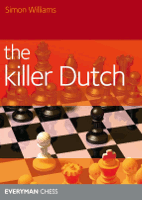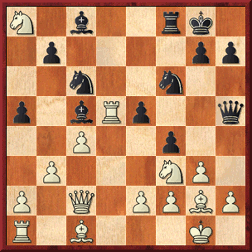Fortune Favors the Bold
Review by Davide Nastasio
The Killer Dutch, by Simon Williams, Everyman Chess 2015, Paperback, Algebraic Notation, 468pp. $29.95 (ChessCafe Price $25.56)
The Dutch is not for every player. It requires a player who is a fierce attacker, and in order to avoid studying a lot of theory in some gambit lines, it requires a player to know the French as well. GM Williams well represents this type of player.
I have a love-hate relationship with the Dutch. I love to study it; I love to watch the games of the great players, Botvinnik especially; but I hate the fact that I cannot win convincingly with the Dutch like GM Williams does. I am trying to learn other openings as black against 1.d4, but it is difficult to switch because I have worked on the Dutch for nearly two years.

I have seen many of GM Williams videos, more than once, and when I saw that he published a book on the Dutch, I knew I had to read it. Williams is such an expert on this opening that many players, Nakamura for one, even change their opening moves to avoid fighting him in the Dutch.
The book begins with a 62-page introductory chapter in which GM Williams lightly comments on ten games! The first chapter covers 7…a5, once known as the Simagin variation; which is an important idea in the Dutch. The a5-pawn is important for Black because it gains space on the queenside, and, of course, creates an outpost on b4 for the knight or bishop.
The second chapter is dedicated to the move 7..Qe8; this is a common maneuver in the Dutch, and was played by legendary players like Tal and Korchnoi. I noticed Williams has a terrible score with this move, so he tends to avoid it. However, as a good theoretician, he presents the material so that the student can learn the ideas behind the Classical Dutch. The third chapter presents another important idea in the Dutch 7…Ne4; Williams does a really good job presenting the main ideas in a way that is easy to remember. He also tells some stories related to these moves and the games he played. Remembering these stories makes it easier to recall the lines, the proper placement for the pieces, and why the moves were played.
In chapter four Williams presents the move 7…Nc6; but more for the sake of completeness because he really does not endorse it. Chapter five covers some of White’s early deviations. One, an early Nh3, is particularly important because White has some good results with it. This is an essential chapter to study over and over.
Chapter six explains what to do when White avoids the fianchetto. Williams explains why this idea is not often seen in GM games. It is here where it is beneficial to know some of the French lines, since if Black begins the game with 1…e6, White deviations such as 2.Bg5 or 2.Nc3 generally cannot be played.
Chapter seven deals with aggressive set-ups and gambits, and Williams does a good job in covering everything. Chapter eight explores the early deviations such as 2.Nc3 and 2.Bg5 for those who do not begin the game with 1…e6. The last two chapters are quite interesting, as GM Williams shows that one can use the Dutch against 1.c4, and he covers lines for those White players who open without 1.d4 or 1.c4. These two last chapters show why one must study the Dutch, because it can be a universal antidote against some of the madness White can throw at us.
Last but not least, in each chapter games are presented, ideas behind the moves that must be remembered, and at the end of each chapter there are few test positions.
This book is clearly a repertoire for Black. Yet all the diagrams are from the white side. I believe it would help the reader to see the positions from the black side. (We prefer to see the diagrams from the white side-ed.) However, one of the reasons the book is so big is not because of content but because the publisher has placed two diagrams per page. The diagrams take up half the space in the book.
Another aspect is that many of the games have been used previously by Williams in his videos on the Dutch. In fact, for some of the games, for instance the ones against Gelfand or Wojtaszek, I believe Williams commented more deeply on the videos. In some ways I like the videos better, because you can feel the enthusiasm in his voice and it is contagious. It is quite funny. I watch his videos, and I want to play the Dutch. I play the Dutch in a tournament, and I want to play something else when the game doesn’t go my way. Then I watch the videos again, and I’m hopelessly hooked like a fish. The trouble with the Dutch can be summed up by something GM Yusupov once said: “The problem with the Dutch is that Black very often in the middlegame finds that his best available move is f5-f7.”
I also would have liked to have seen more explanations to the annotated moves. For example, there are instances when Williams gives a symbol to a move, say “!?”, but then doesn’t explain why that move is interesting. Or there might be a diagram for a position but no commentary as to why this particular position is important.
A final nit is that the ideas and analysis in chapter four were presented in the book Dangerous Weapons: The Dutch as GM Williams readily admits.
I’d like to now present one of GM Williams’s gems:
Wojtaszek,Radoslaw (2721) – Williams,Simon (2520)
FRA-chT Top 12 Mulhouse (1.1), 26.05.2011
1.d4 e6 2.Nf3 f5 3.g3 Nf6 4.Bg2 Be7 5.0-0 0-0 6.c4 d6 7.Qc2 a5

[FEN “rnbq1rk1/1pp1b1pp/3ppn2/p4p2/2PP4/5NP1/PPQ1PPBP/RNB2RK1 w – – 0 8”]
Here Black is fighting for control of b4, but Williams doesn’t explain why White doesn’t fight back. Black fights for b4, because the real target is the queen on c2! The goal is to play e6-e5, but Black needs a tempo to make that happen. He gains that tempo with the maneuver Nc6-b4.
8.Nc3 Nc6 9.b3
White is not challenging Black on b4, this is a big problem.
9…e5 10.dxe5 dxe5 11.Rd1 Qe8
The queen wants to go to h5 to increase the pressure on the kingside.
12.Nb5

[FEN “r1b1qrk1/1pp1b1pp/2n2n2/pN2pp2/2P5/1P3NP1/P1Q1PPBP/R1BR2K1 b – – 0 12”]
Williams makes an interesting comment here. The goal of the game is to give checkmate. So should Black worry about giving checkmate or about the Pc7? Given that his opponent is about 200 points above him, Williams made a choice to try to win using a line that cannot be calculated by humans.
12…Qh5 13.Nxc7 f4 14.Nxa8 Bc5
Black is now pointing at f2.
15.Rd5?

[FEN “N1b2rk1/1p4pp/2n2n2/p1bRp2q/2P2p2/1P3NP1/P1Q1PPBP/R1B3K1 b – – 0 15”]
Williams notes that 15.gxf4 was correct. Obviously, it is quite difficult to find, and counter-intuitive, because it weakens the pawn protection in front of the king.
15…Nb4 16.Rxe5 Nxc2 17.Rxh5 Nxh5 18.Rb1 fxg3 19.hxg3 Nxg3 20.Rb2 Bf5 0-1
Williams ends this game with the Latin proverb “Fortes fortuna adiuvat.”
My assessment of this product:
![]()
Order The Killer Dutch
by Simon Williams
A PDF file of this week’s review, along with all previous reviews, is available in the ChessCafe.com Archives.
© 2015 ChessEdu.org. All Rights Reserved.




Leave a Reply